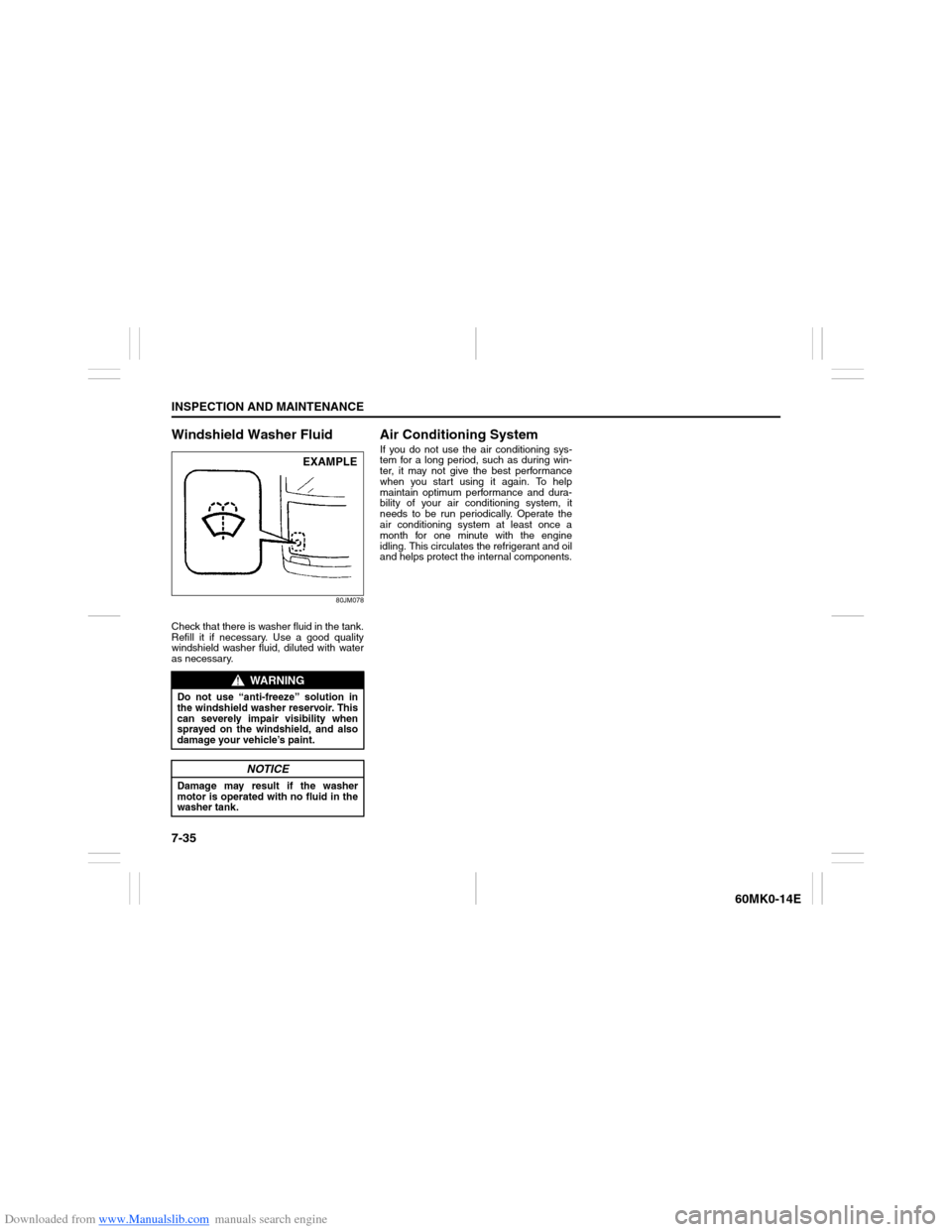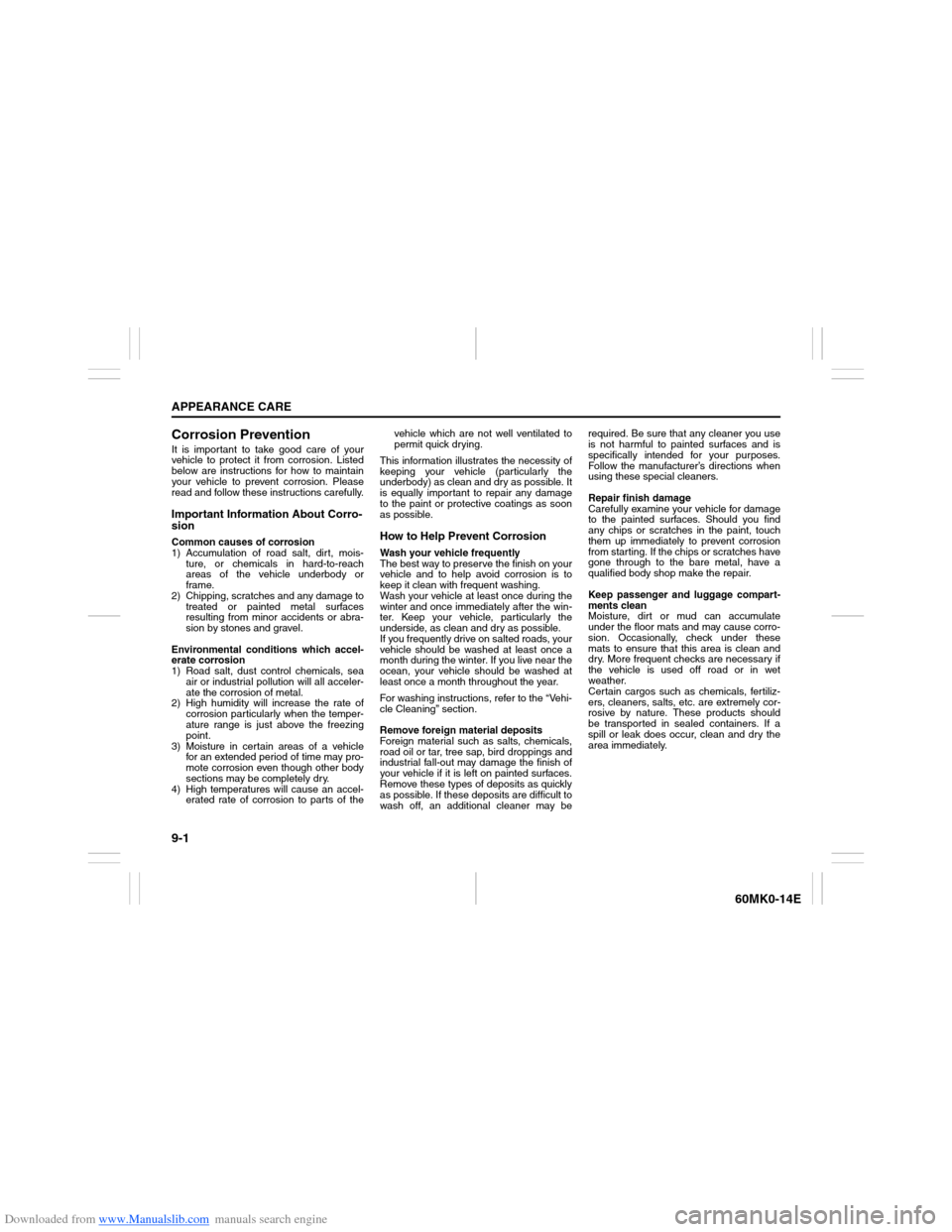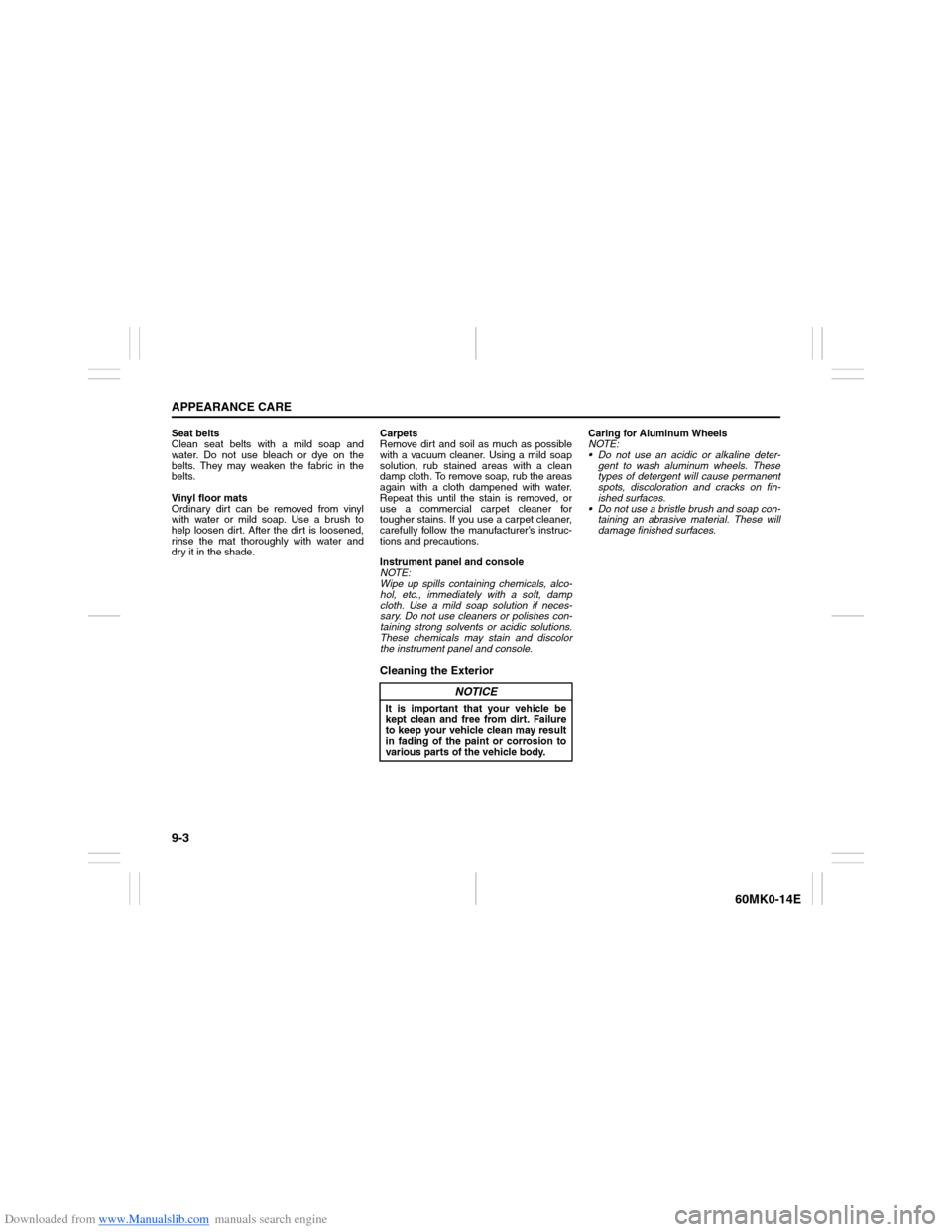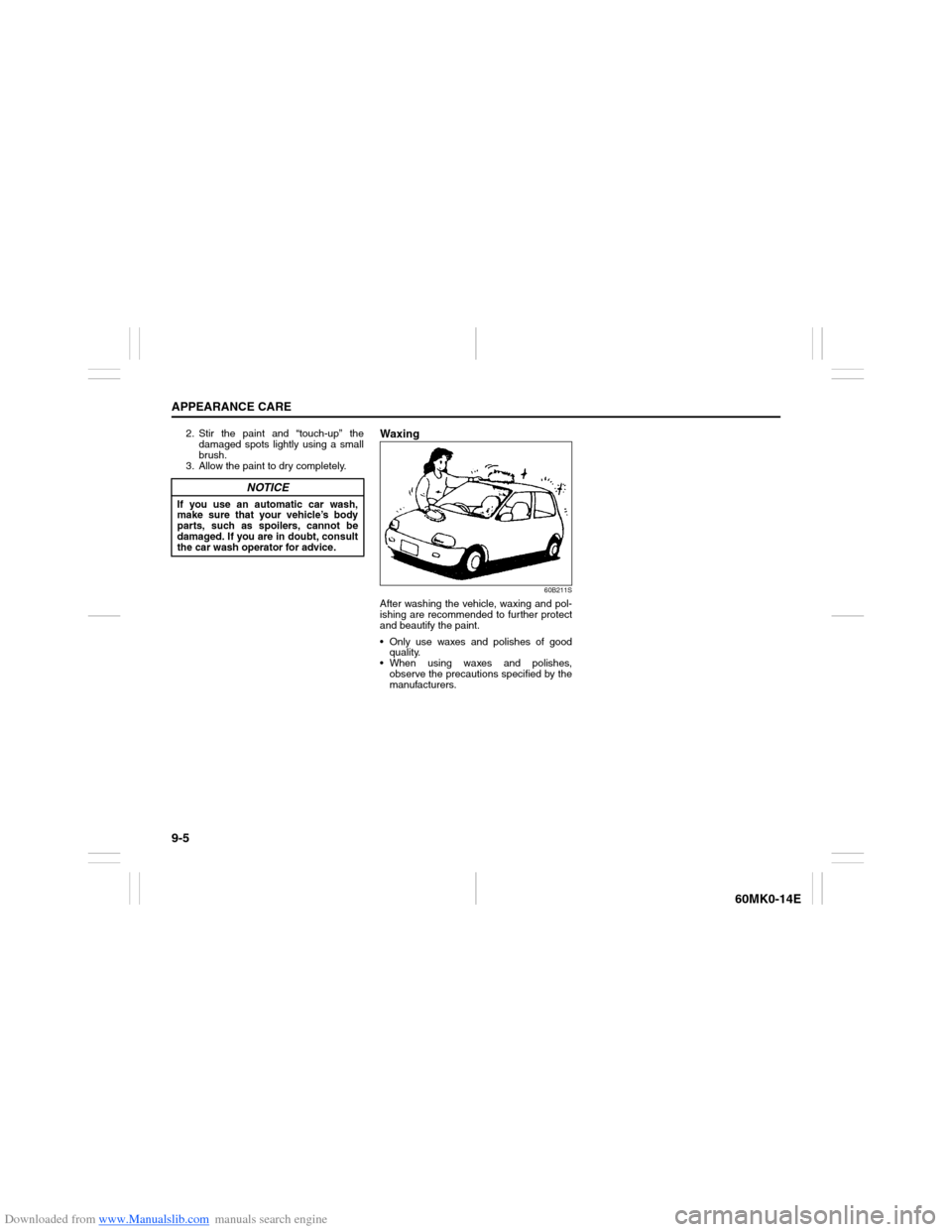2013 SUZUKI ERTIGA oil
[x] Cancel search: oilPage 171 of 207

Downloaded from www.Manualslib.com manuals search engine 7-26
INSPECTION AND MAINTENANCE
60MK0-14E
81A283
Headlight AimingSince special procedures are required, we
recommend you take your vehicle to your
SUZUKI dealer for headlight alignment.
Bulb Replacement
WARNING
Always be sure to replace a blown
fuse with a fuse of the correct amper-
age. Never use a substitute such as
aluminum foil or wire to replace a
blown fuse. If you replace a fuse and
the new one blows in a short period
of time, you may have a major electri-
cal problem. Have your vehicle
inspected immediately by your
SUZUKI dealer.
BLOWN OK
CAUTION
Light bulbs can be hot enough to
burn your finger right after being
turned off. This is true especially
for halogen headlight bulbs.
Replace the bulbs after they
become cool enough.
The headlight bulbs are filled with
pressurized halogen gas. They can
burst and injure you if they are hit
or dropped. Handle them carefully.
NOTICE
The oils from your skin may cause a
halogen bulb to overheat and burst
when the lights are on. Grasp a new
bulb with a clean cloth.
NOTICE
Frequent replacement of a bulb indi-
cates the need for an inspection of
the electrical system. This should be
carried out by your SUZUKI dealer.
Page 180 of 207

Downloaded from www.Manualslib.com manuals search engine 7-35INSPECTION AND MAINTENANCE
60MK0-14E
Windshield Washer Fluid
80JM078
Check that there is washer fluid in the tank.
Refill it if necessary. Use a good quality
windshield washer fluid, diluted with water
as necessary.
Air Conditioning SystemIf you do not use the air conditioning sys-
tem for a long period, such as during win-
ter, it may not give the best performance
when you start using it again. To help
maintain optimum performance and dura-
bility of your air conditioning system, it
needs to be run periodically. Operate the
air conditioning system at least once a
month for one minute with the engine
idling. This circulates the refrigerant and oil
and helps protect the internal components.
WARNING
Do not use “anti-freeze” solution in
the windshield washer reservoir. This
can severely impair visibility when
sprayed on the windshield, and also
damage your vehicle’s paint.
NOTICE
Damage may result if the washer
motor is operated with no fluid in the
washer tank.
EXAMPLE
Page 190 of 207

Downloaded from www.Manualslib.com manuals search engine 8-9EMERGENCY SERVICE
60MK0-14E
If the Engine OverheatsThe engine could overheat temporarily
under severe driving conditions. If the
engine coolant temperature gauge indi-
cates overheating during driving:
1) Turn off the air conditioner, if equipped.
2) Take the vehicle to a safe place and
park.
3) Let the engine run at the normal idle
speed for a few minutes until the indica-
tor is within the normal, acceptable
temperature range between “H” and
“C”.If the temperature indication does not
come down to within the normal, accept-
able range:
1) Turn off the engine and check that the
water pump belt and pulleys are not
damaged or slipping. If any abnormality
is found, correct it.
2) Check the coolant level in the reservoir.
If it is found to be lower than the “LOW”
line, look for leaks at the radiator, water
pump, and radiator and heater hoses. If
you locate any leaks that may have
caused the overheating, do not run the
engine until these problems have been
corrected.
3) If you do not find a leak, carefully add
coolant to the reservoir and then the
radiator, if necessary. (Refer to “Engine
Coolant” in the “INSPECTION AND
MAINTENANCE” section.)
NOTE:
If your engine overheats and you are
unsure what to do, contact your SUZUKI
dealer.
79J007
WARNING
If you see or hear escaping steam,
stop the vehicle in a safe place and
immediately turn off the engine to let
it cool. Do not open the hood when
steam is present. When the steam
can no longer be seen or heard, open
the hood to see if the coolant is still
boiling. If it is, you must wait until it
stops boiling before you proceed.
WARNING
It is hazardous to remove the radia-
tor cap (or degassing tank cap for a
diesel engine) when the water tem-
perature is high, because scalding
fluid and steam may be blown out
under pressure. The cap should
only be taken off when the coolant
temperature has lowered.
To help prevent personal injury,
keep hands, tools and clothing
away from the engine cooling fan
and air-conditioner fan (if
equipped). These electric fans can
automatically turn on without warn-
ing.
Page 192 of 207

Downloaded from www.Manualslib.com manuals search engine 9-1APPEARANCE CARE
60MK0-14E
Corrosion PreventionIt is important to take good care of your
vehicle to protect it from corrosion. Listed
below are instructions for how to maintain
your vehicle to prevent corrosion. Please
read and follow these instructions carefully.Important Information About Corro-
sionCommon causes of corrosion
1) Accumulation of road salt, dirt, mois-
ture, or chemicals in hard-to-reach
areas of the vehicle underbody or
frame.
2) Chipping, scratches and any damage to
treated or painted metal surfaces
resulting from minor accidents or abra-
sion by stones and gravel.
Environmental conditions which accel-
erate corrosion
1) Road salt, dust control chemicals, sea
air or industrial pollution will all acceler-
ate the corrosion of metal.
2) High humidity will increase the rate of
corrosion particularly when the temper-
ature range is just above the freezing
point.
3) Moisture in certain areas of a vehicle
for an extended period of time may pro-
mote corrosion even though other body
sections may be completely dry.
4) High temperatures will cause an accel-
erated rate of corrosion to parts of thevehicle which are not well ventilated to
permit quick drying.
This information illustrates the necessity of
keeping your vehicle (particularly the
underbody) as clean and dry as possible. It
is equally important to repair any damage
to the paint or protective coatings as soon
as possible.
How to Help Prevent CorrosionWash your vehicle frequently
The best way to preserve the finish on your
vehicle and to help avoid corrosion is to
keep it clean with frequent washing.
Wash your vehicle at least once during the
winter and once immediately after the win-
ter. Keep your vehicle, particularly the
underside, as clean and dry as possible.
If you frequently drive on salted roads, your
vehicle should be washed at least once a
month during the winter. If you live near the
ocean, your vehicle should be washed at
least once a month throughout the year.
For washing instructions, refer to the “Vehi-
cle Cleaning” section.
Remove foreign material deposits
Foreign material such as salts, chemicals,
road oil or tar, tree sap, bird droppings and
industrial fall-out may damage the finish of
your vehicle if it is left on painted surfaces.
Remove these types of deposits as quickly
as possible. If these deposits are difficult to
wash off, an additional cleaner may berequired. Be sure that any cleaner you use
is not harmful to painted surfaces and is
specifically intended for your purposes.
Follow the manufacturer’s directions when
using these special cleaners.
Repair finish damage
Carefully examine your vehicle for damage
to the painted surfaces. Should you find
any chips or scratches in the paint, touch
them up immediately to prevent corrosion
from starting. If the chips or scratches have
gone through to the bare metal, have a
qualified body shop make the repair.
Keep passenger and luggage compart-
ments clean
Moisture, dirt or mud can accumulate
under the floor mats and may cause corro-
sion. Occasionally, check under these
mats to ensure that this area is clean and
dry. More frequent checks are necessary if
the vehicle is used off road or in wet
weather.
Certain cargos such as chemicals, fertiliz-
ers, cleaners, salts, etc. are extremely cor-
rosive by nature. These products should
be transported in sealed containers. If a
spill or leak does occur, clean and dry the
area immediately.
Page 194 of 207

Downloaded from www.Manualslib.com manuals search engine 9-3APPEARANCE CARE
60MK0-14E
Seat belts
Clean seat belts with a mild soap and
water. Do not use bleach or dye on the
belts. They may weaken the fabric in the
belts.
Vinyl floor mats
Ordinary dirt can be removed from vinyl
with water or mild soap. Use a brush to
help loosen dirt. After the dirt is loosened,
rinse the mat thoroughly with water and
dry it in the shade.Carpets
Remove dirt and soil as much as possible
with a vacuum cleaner. Using a mild soap
solution, rub stained areas with a clean
damp cloth. To remove soap, rub the areas
again with a cloth dampened with water.
Repeat this until the stain is removed, or
use a commercial carpet cleaner for
tougher stains. If you use a carpet cleaner,
carefully follow the manufacturer’s instruc-
tions and precautions.
Instrument panel and console
NOTE:
Wipe up spills containing chemicals, alco-
hol, etc., immediately with a soft, damp
cloth. Use a mild soap solution if neces-
sary. Do not use cleaners or polishes con-
taining strong solvents or acidic solutions.
These chemicals may stain and discolor
the instrument panel and console.
Cleaning the Exterior
Caring for Aluminum Wheels
NOTE:
Do not use an acidic or alkaline deter-
gent to wash aluminum wheels. These
types of detergent will cause permanent
spots, discoloration and cracks on fin-
ished surfaces.
Do not use a bristle brush and soap con-
taining an abrasive material. These will
damage finished surfaces.
NOTICE
It is important that your vehicle be
kept clean and free from dirt. Failure
to keep your vehicle clean may result
in fading of the paint or corrosion to
various parts of the vehicle body.
Page 196 of 207

Downloaded from www.Manualslib.com manuals search engine 9-5APPEARANCE CARE
60MK0-14E
2. Stir the paint and “touch-up” the
damaged spots lightly using a small
brush.
3. Allow the paint to dry completely.
Waxing
60B211S
After washing the vehicle, waxing and pol-
ishing are recommended to further protect
and beautify the paint.
Only use waxes and polishes of good
quality.
When using waxes and polishes,
observe the precautions specified by the
manufacturers.
NOTICE
If you use an automatic car wash,
make sure that your vehicle’s body
parts, such as spoilers, cannot be
damaged. If you are in doubt, consult
the car wash operator for advice.
Page 202 of 207

Downloaded from www.Manualslib.com manuals search engine 11-4SPECIFICATIONS
60MK0-14E
*1 If you cannot prepare a tire with the specified load index rate and speed symbol, prepare a tire with higher load index rate and speed
symbol. ITEM: Wheel and Suspension
Tire size, front and rear 185/65R15 88H
*1
Rim size 185/65R15 tire: 15X5 1/2J
Tire pressures For the specified tire pressure, see the Tire Information Label located
on the driver’s door lock pillar.
ITEM: Capacities (approx.)
Coolant (including reservoir tank) M/T 4.5 L (7.9 lmp pt)
A/T 4.4 L (7.7 lmp pt)
Fuel tank 45 L (9.9 Imp gal)
Engine oil 3.1 L (5.5 Imp pt) (replacement with oil filter)
Transaxle oil M/T 2.6 L (4.5 Imp pt)
A/T 5.0 L (8.8 Imp pt)
Page 203 of 207

Downloaded from www.Manualslib.com manuals search engine 12-1
INDEX
12
60MK0-14E
INDEXSymbols“AIR BAG” Light .................................................................. 2-40Numerics4-Speed Automatic Transaxle ............................................ 3-10AAccelerator Pedal .................................................................. 3-7
Accessory Socket ................................................................ 5-41
Adding Coolant .................................................................... 7-12
Adjusting Seat Position ...................................................... 2-14
Adjusting Seat Position (for 2nd row seats) ..................... 2-16
Adjusting Seatbacks .................................................. 2-15, 2-16
Air Cleaner............................................................................ 7-13
Air Conditioning System .............................................. 5-1, 7-35
All Seat Belts Except Center of 2nd Row Seat.................. 2-23
Anti-Lock Brake System (ABS) .......................................... 3-13
Anti-Lock Brake System (ABS) Warning Light ................. 2-39
Anti-Theft Feature ................................................................ 5-31
Armrest ................................................................................. 5-44
Assist Grips.......................................................................... 5-42
Audio System ......................................................................... 5-7
Automatic Transaxle ........................................................... 3-10
Automatic Transaxle (AT) Fluid.......................................... 7-16
Average fuel consumption......................................... 2-47, 2-49BBattery .................................................................................. 7-22
Bottle holder......................................................................... 5-43
Brake Assist System ........................................................... 3-13
Brake Fluid ........................................................................... 7-17
Brake Pedal ................................................................... 3-7, 7-18Brake System Warning Light .............................................. 2-38
Brakes ................................................................................... 7-17
Braking .................................................................................. 3-12
Brightness Control............................................................... 2-45
Bulb Replacement ................................................................ 7-26
CCatalytic Converter ................................................................ 4-1
CD Player .............................................................................. 5-15
Center Seat Belt of 2nd Row Seat ...................................... 2-24
Central Door Locking System ............................................... 2-3
Changing Engine Oil and Filter............................................. 7-9
Changing Wheels ................................................................... 8-5
Charging Light...................................................................... 2-40
Chassis Serial Number ........................................................ 10-1
Child Restraint Systems ...................................................... 2-27
Child-Proof Locks (rear door) ............................................... 2-3
Clock ..................................................................................... 2-50
Clutch Pedal .................................................................. 3-7, 7-16
Coolant Level Check ............................................................ 7-12
Coolant Replacement .......................................................... 7-12
Corrosion Prevention ............................................................ 9-1
Cup Holder and Storage Area ............................................. 5-43DDaily Inspection Checklist..................................................... 3-1
Door Locks ............................................................................. 2-2
Downshifting maximum allowable speeds .......................... 3-9
Drive Belt ................................................................................ 7-7
Driver’s Seat Belt Reminder ................................................ 2-25
Driver’s Seat Belt Reminder Light ...................................... 2-40
Driving on Hills ....................................................................... 4-3
Driving on Slippery Roads .................................................... 4-4